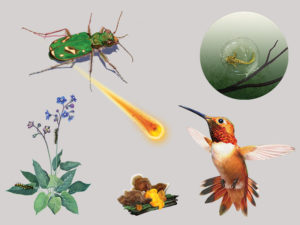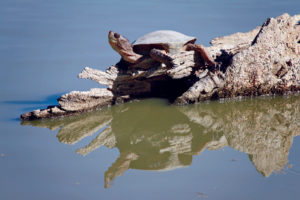Our temperate climate here in the Bay Area means that most inhabitants don’t have to hibernate. Hibernation is a form of adaptive hypothermia, a continuum of responses to climatic variations that allow an animal to save energy by temporarily abandoning the effort required to maintain a constant body temperature. When freezing temperatures and snow reduce the availability of food, the energy an animal expends to seek out remaining scarce food sources is greater than the likely return in energy gained from consuming that food. In addition, staying active in colder temperatures requires more energy than in warmer weather. So in regions with cold winters, animals that can significantly reduce their energy needs will do better.
At one end of the hypothermia continuum is shallow hypothermia, a kind of deep sleep where body temperature only drops within 10ºC of normal. This is the case with black bears which, even in very cold climates, don’t truly hibernate. Our local bears are able to forgo winter slumber entirely. At the opposite end of the hypothermia continuum is torpor, or profound hypothermia. In this case, body temperature falls to within 1ºC of ambient temperature, along with a drop in breathing and heart rate. Such winter torpor is hibernation. (Summer torpor, brought on by heat and the absence of moisture, is called estivation.)
In the Bay Area, it doesn’t generally get cold enough to cause shortages of prey and forage, so most warm-blooded creatures (endotherms) don’t need to close up shop in winter. Some local bats do hibernate—in caves, tree cavities, attics, or under tree bark—during the colder months, when significantly fewer of their insect prey are available.
Unlike endotherms, which remain active in cooler winter temperatures by increasing internal heat (energy) production, cold-blooded animals (ectotherms) such as amphibians and reptiles are dependent on rising ambient temperature to warm up and resume activity. So in the cooler winter months here, amphibians and reptiles seek a safe refuge (hibernaculum) where the temperature remains above freezing and where relative humidity remains fairly constant. Caves, rock crevices, underground burrows, decaying logs and stumps, sawdust piles, and even mud and debris on the bottoms of lakes and ponds are possible places of refuge.
In our local Mediterranean climate, most plants and animals will prosper instead of slowing down during the wet and temperate winters. This is perhaps a major reason why the Bay Area is one of the five top biodiversity hot spots in North America.




